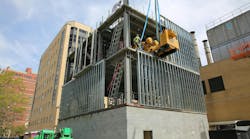Each of the Annex D examples illustrates a different application. The first steps are always the same:
- Describe the problem (based on the one-line diagram)
- Characterize the loads as either continuous or noncontinuous
- Determine the calculated load
No matter what the application, the subsequent steps depend upon correctly completing these first steps.
The first five Annex D examples are for residential applications. Even if you do only commercial and industrial work, carefully reading these is helpful. The same principles apply as for industrial and commercial. The difference is with residential your load calculations include specific circuits such as those for ranges and clothes dryers.
Annex D3 is a commercial example, in this case a storefront. It provides a fairly simple illustration of the sequence of calculations that end with feeder conductor sizing. As for load calculations, it provides the twist that the actual connected load is less than the Table 220.12 load. You have to use the larger of the two values, so in the case of Example D3 you must use the Table 220.12 load.
Annex D3(a) throws in two twists, not just one:
- Demand factors
- Motor loads
For industrial applications, you'll always have motor loads and it's unlikely you won't need to apply demand factors. Study D3(a) thoroughly.


